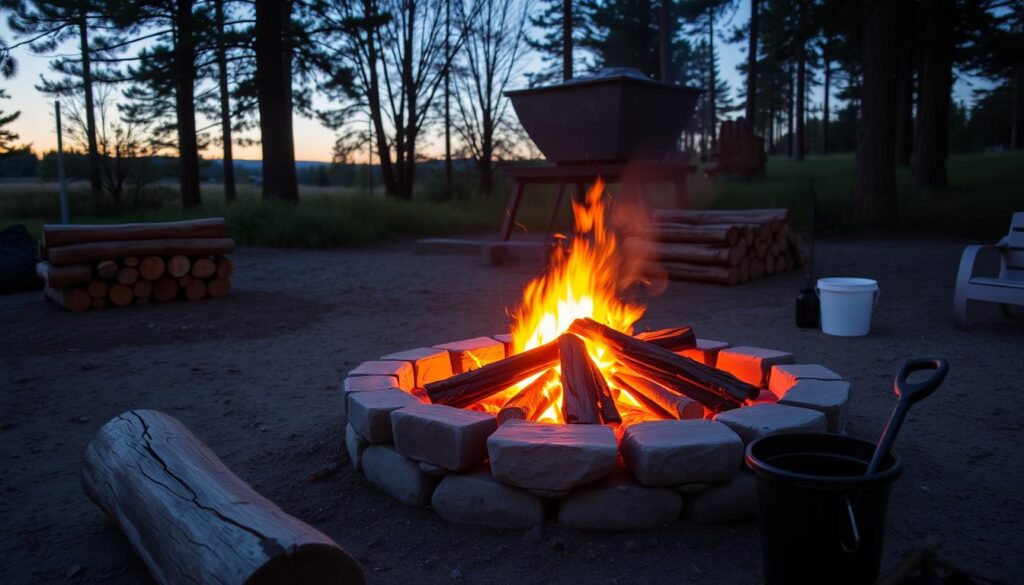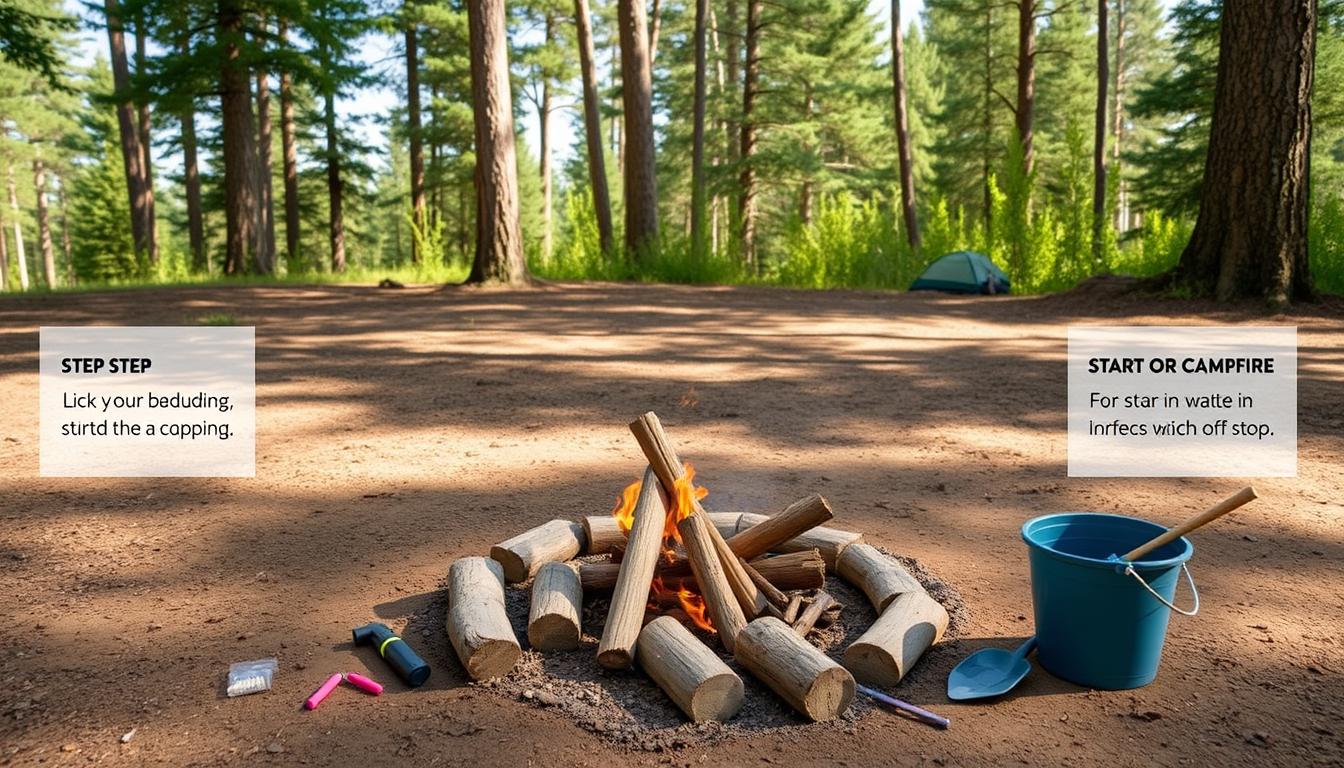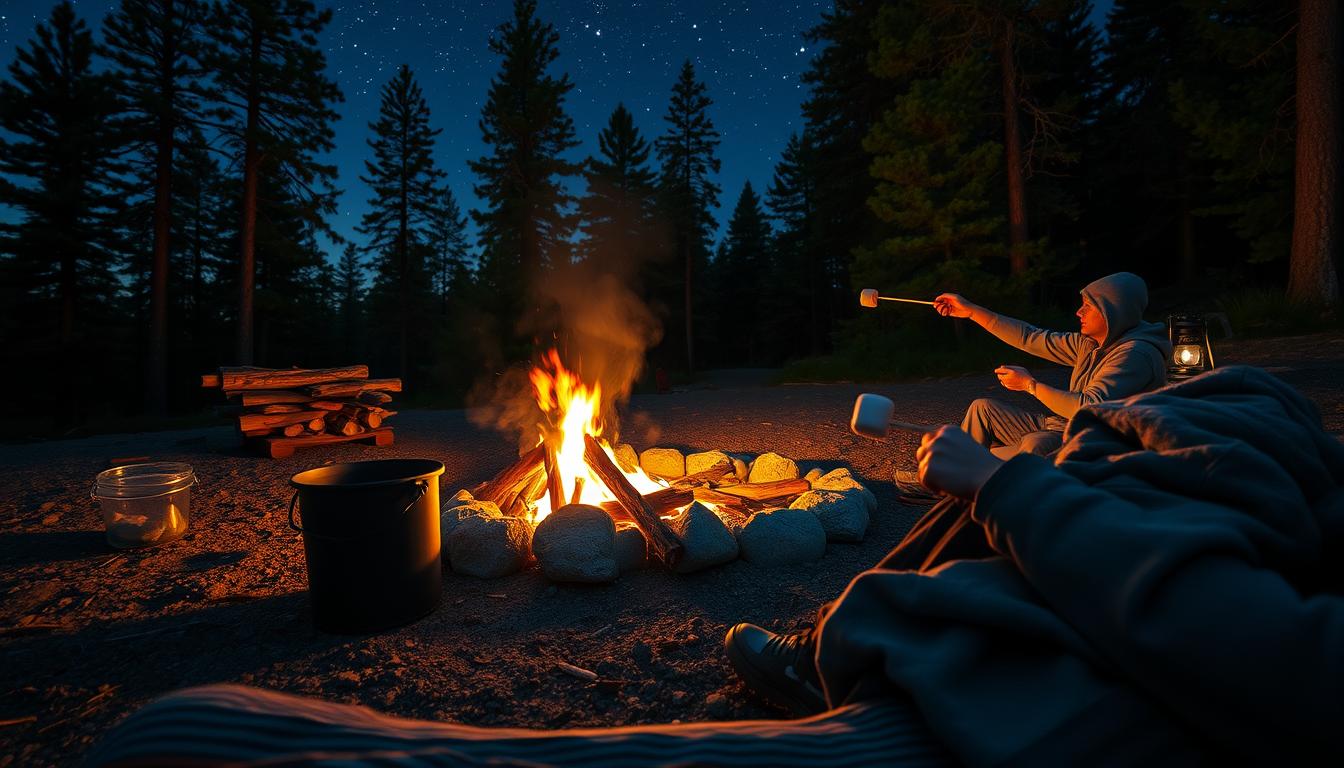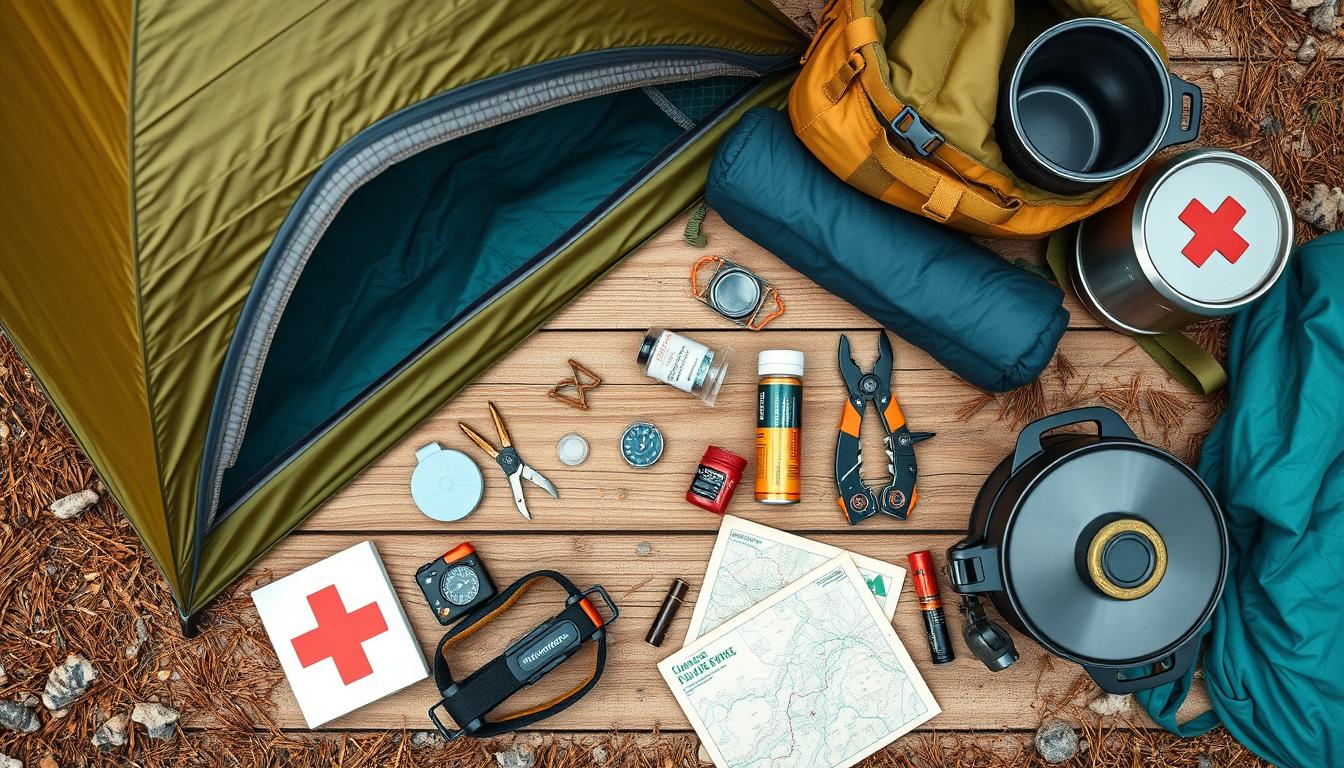Starting a campfire safely is key to a great outdoor adventure. This guide will teach you how to start a campfire safely. You’ll learn important safety tips and how to build a fire step by step. We’ll cover everything from picking the right spot to putting out the fire.
Key Takeaways
- Understanding campfire safety is crucial for outdoor enjoyment.
- Choosing a safe location is the first step in starting a campfire.
- Gather the right materials, including fuel, kindling, and tinder.
- Follow structured fire building steps to create a safe fire.
- Always monitor your campfire to maintain safety.
- Properly extinguish your fire to protect the environment.
- Teach children about campfire safety to ensure their well-being.
Understanding Campfire Safety
Knowing how to keep campfires safe is key for outdoor lovers. Campfires are great for warmth and cooking but can be dangerous if not managed right. I’ll talk about why campfire safety is crucial, the dangers of not being careful, and how to protect the environment.
Importance of Campfire Safety
Campfire safety is very important. Every year, many wildfires start from campfires that got out of control. These fires can harm wildlife, damage property, and put people in danger. By following safety rules, I can enjoy a campfire safely and have a good time outdoors.
Risks Involved with Campfires
It’s vital to know the dangers of campfires. Some common risks are:
- Uncontrolled Flames: A small mistake can make a fire spread fast.
- Accidental Injuries: Sparks and hot embers can cause burns or injuries.
- Wildfire Potential: Fires can cause long-term damage to the environment if they get out of control.
- Property Damage: Fires can destroy personal belongings if they spread.
By understanding these risks, I can make sure camping is safe for everyone.
| Risk | Consequences | Prevention Measures |
|---|---|---|
| Uncontrolled Flames | Wildfires, injury | Use designated fire rings, control size |
| Accidental Burns | Pain, medical attention | Maintain distance, use protective gear |
| Wildfire Spread | Environmental damage | Regularly check surroundings, extinguish properly |
| Property Damage | Loss of belongings | Stay aware, follow guidelines |
By taking these steps, we can make campfires safer for everyone. This follows the main rules of safe outdoor activities.
Essential Campfire Safety Precautions
Before starting a campfire, it’s crucial to follow key safety steps. These steps keep both campers and the environment safe. A big part of this is picking the right spot for your fire.
Choosing a Safe Location
When picking a fire spot, think about these things:
- Avoid areas with dry grass or leaves.
- Make sure there are no branches hanging over.
- Keep it at least 15 feet away from tents and other things that can catch fire.
Being careful about where you build your fire greatly lowers the chance of fires starting. Knowing the land helps a lot with keeping fires safe.
Checking Weather Conditions
Before lighting the fire, I always check the weather. Wind can make fires spread fast and out of control. Also, dry weather can make the ground more likely to catch fire. Here are some things to watch:
- Wind speed and direction.
- How much rain has fallen recently.
- Temperature and how humid it is.
By adding these steps to my planning, I make sure camping is safer and more fun. Here’s a visual to show these safety tips:
How to Start a Campfire Safely: Step-by-Step Guide
Starting a campfire safely is key for a great outdoor time. I use a simple guide to make it easy and safe. Each step helps make the campfire safe and fun.
- Prepare the Fire Site: Pick a spot clear of flammable stuff. Use a fire pit if you can.
- Gather Your Materials: Make sure you have tinder, kindling, and fuel wood ready.
- Position Your Materials: Put tinder in a small pile in the fire pit. Add kindling around it in a teepee shape for air.
- Ignite the Fire: Light the tinder with matches or a lighter. Try to light it from different sides to catch well.
- Add Fuel Wood: Add bigger sticks as the fire grows. Make sure air can get to it to keep it burning.
- Monitor the Fire: Always watch the fire. Be ready to put it out or control it if needed.
By following these steps, I’m sure I can start a campfire safely. Each step makes the experience better, ensuring warmth and fun without safety risks.
Gathering Your Materials
Gathering campfire materials is key to a successful fire. Choosing the right fuel and preparing everything is important. Knowing what you need makes starting a campfire easier.
Choosing the Right Fuel
Finding the right fuel is crucial for a good burn. Here are some common options:
- Wood Logs: These are traditional and abundant. Hardwoods like oak and maple burn long.
- Softwoods: Pine and fir burn fast, perfect for starting fires.
- Charcoal: Great for grilling, it also works as fuel for a controlled fire.
- Commercial Fire Starters: These make starting a fire easy and provide a steady flame.
Gathering Kindling and Tinder
Kindling and tinder are essential for starting a fire. They help ignite the flames:
- Tinder: This is dry, lightweight material like leaves or paper that catches fire easily.
- Kindling: Small sticks or twigs that catch fire from tinder help build a bigger fire.
Spending time on good kindling and tinder ensures a great campfire. Proper preparation makes outdoor fun.

Fire Building Steps
After gathering all necessary materials, I focus on the fire building steps to ensure an efficient and safe campfire. Proper arrangement of firewood is key to a good burn. Knowing the right fire technique is crucial for a lasting flame.
Arranging Your Firewood
Correctly arranging firewood is vital for airflow and efficient burning. Here are some effective methods:
- Teepee Structure: Place kindling in the center, surrounded by larger logs leaning against each other, creating a teepee shape. This method encourages excellent airflow.
- Log Cabin Style: Build a square base using larger logs, stacking more logs in layers, similar to a log cabin. This style allows for easy access to add more wood as the fire burns down.
- Parallel Stacks: For a slower burn, stack firewood in parallel lines, allowing air to circulate between the stacks.
Choosing the Right Fire Technique
Selecting the right fire technique is crucial for the fire’s longevity and heat output. Different techniques are best for different situations:
| Fire Technique | Best Use | Advantages |
|---|---|---|
| Teepee | Quick start & heat | Good airflow, easy to ignite |
| Log Cabin | Longer burns | Stable structure, easy to add fuel |
| Parallel Stacks | Slow, steady burns | Long-lasting heat, minimal maintenance |
Starting a Fire Safely
Starting a fire safely is key. It’s important to learn how to use matches or lighters right. This helps me light the fire without taking risks. Matches are simple, while lighters are handy, but both need careful use to avoid accidents.
Make sure the area is dry and not windy. This helps a lot when trying to light the fire.
Using Matches or Lighters
For the best fire starting, use waterproof matches or a good lighter. Hold the match or lighter close to the tinder. Strike it hard to get a steady flame.
Keep a safe distance to avoid burns. Also, watch the wind direction. Directing the flame at the fire materials helps a lot.
Creating Airflow for the Fire
Good airflow is key for a fire to keep burning. Once lit, arrange logs to let air flow. This helps the fire grow stronger.
Adjusting the logs or tilting them helps airflow. This keeps the fire burning well and safely. It makes the fire warm and cozy without worries.
These steps help start a fire safely and make outdoor time better. For more campfire tips, check out starting a campfire safely.
Maintaining Your Campfire
Keeping a campfire safe and enjoyable is key while camping. Knowing how to keep the fire burning well makes camping better. It’s not just about starting the fire but also watching it as it burns.
By keeping an eye on the fire, you can stop it from getting too big.
How to Keep the Fire Burning
To keep a campfire going, adjust the wood and add fuel when needed. Here are some tips for a great fire:
- Use seasoned firewood for better burning.
- Put bigger logs at the bottom and smaller sticks on top.
- Move wood to improve airflow.
- Don’t use wet wood, as it can kill the fire.
Monitoring the Fire at All Times
Watching the fire is crucial for safety and control. Regular checks help spot any fire behavior changes. Important steps for monitoring include:
- Keep an eye on the fire’s size.
- Watch for sparks that may escape.
- Be ready for wind changes that can spread embers.
- Always have water or dirt nearby for emergencies.
Understanding the importance of maintaining a campfire and watching it closely makes camping safe for everyone. Good practices keep the fire burning and make the outdoor experience fun and safe.
Campfire Tips from Experts
Enjoying a campfire is better with advice from those who know. The right tips make sure my food tastes great and is safe to eat.
Common Mistakes to Avoid
Many campers make mistakes that can be dangerous or ruin their meal. Here are some to avoid:
- Using Green Wood: Fresh wood is too wet and hard to light.
- Neglecting Fire Size: A fire too big can get out of control. One too small won’t cook food well.
- Ignoring Wind Direction: Wind can spread embers and smoke, affecting food and people.
- Not Preparing Ingredients: Not cutting meat or veggies ahead of time can slow down cooking.
Best Practices for Campfire Cooking
Knowing how to cook over a campfire makes meals better. Here are some key tips:
- Use Cooking Grids: Cooking pots above the flames helps with heat and keeps them clean.
- Skewering: Skewers help cook meat and veggies evenly and make turning them easy.
- Layer Ingredients: Put denser foods at the bottom of stews or foil packs for even cooking.
- Cover the Cooking Area: A shield keeps ash out of food and protects the fire from wind.

Using these tips and avoiding common mistakes makes cooking outdoors fun and tasty. Following the best practices ensures a delicious meal under the stars.
Extinguishing Your Campfire Properly
Safely putting out a campfire is key to stopping wildfires and protecting nature. It’s important to know when and how to do it right. This ensures the campsite is safe for others and wildlife.
When and How to Put Out the Fire
It’s crucial to know when to extinguish the fire. If it’s time to leave or the fire is dying down, it’s time to put it out. Here are some effective methods:
- Douse with Water: Slowly pour water over the fire to soak all embers.
- Digging a Pit: Without water, dig a hole to smother the fire.
- Stirring the Ashes: Mix ashes with dirt and water to cool all embers.
Ensuring the Fire is Completely Out
Checking that the fire is fully out is a must. After putting out the fire, I make sure there’s no heat left. This includes:
- Feeling the ashes with the back of my hand. If they’re warm, I keep cooling them.
- Checking that the ground around the fire pit is cold.
- Looking for any smoke or steam, signs of hot spots.
Safe Campfire Practices for Kids
Teaching kids about campfire safety is key for outdoor fun. It’s important to learn how to have a safe campfire. I think hands-on learning and watching over kids helps them understand fire dangers.
Teaching Campfire Safety to Children
Teaching campfire safety is fun when you mix learning with activities. Here are some tips to make it stick:
- Always have adult supervision: Grown-ups should watch over kids during campfire time.
- Demonstrate proper fire safety: Show kids how to start a fire right and why they should stay back.
- Use age-appropriate language: Explain things in a way kids can get, using examples they can relate to.
- Encourage questions: Make it okay for kids to ask about fire safety and why it’s important.
- Teach the “stop, drop, and roll” method: Teach kids what to do if they catch on fire.
By using these methods, kids learn fire safety well. Teaching them early helps them become careful and respectful campers. Learning about safe campfires means everyone can have fun outdoors safely.
Campfire Etiquette
Knowing how to behave around a campfire is key to a great camping trip. I always try to be considerate of nature and the people around me. By following some simple rules, we can all enjoy the outdoors more.
Respecting Nature and Other Campers
When I’m with friends by the campfire, I keep an eye on my surroundings. Here are a few important things to remember:
- Keep noise levels low to respect the tranquility of nature and fellow campers.
- Avoid littering in the campsite area. Instead, I pack out what I bring in and dispose of waste properly.
- Stay within designated fire rings to prevent damage to the surrounding flora.
Following Local Regulations
Before starting a campfire, I check the local rules. Important rules often include:
- Checking for any fire bans before the trip.
- Abiding by specific campsite rules regarding campfire size and designated areas.
- Remaining cautious during dry seasons or in drought-stricken areas.
Conclusion
Starting a campfire safely is a big deal. We’ve covered the basics, like picking the right spot and watching the weather. These steps help keep you safe and make your camping trip better.
We talked about how to build and keep a fire going. It’s all about airflow and watching the flames. This way, camping becomes a fun, safe experience. And when it’s time to leave, putting out the fire right helps protect nature.
As we finish up, I want you to remember these tips. I hope you’ll use them to enjoy the outdoors responsibly. Let’s enjoy nature and keep it safe for everyone. Happy camping!





Leave a Reply